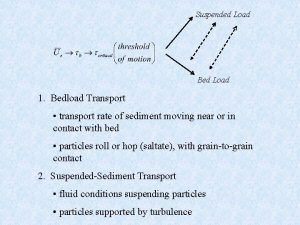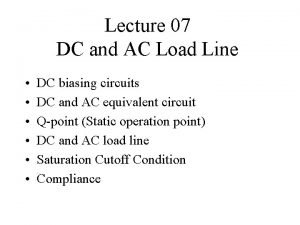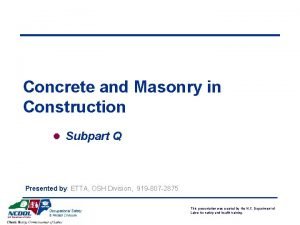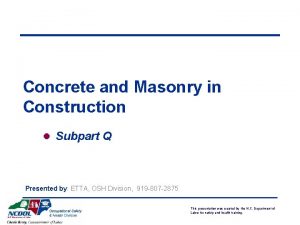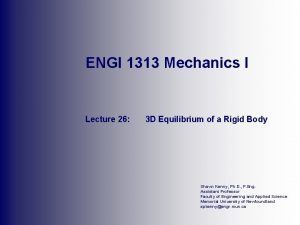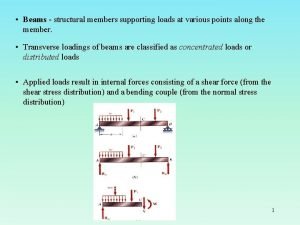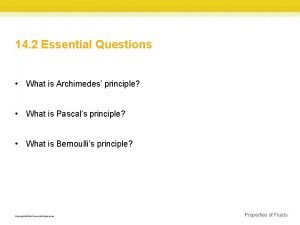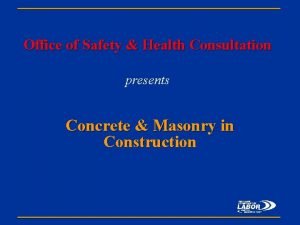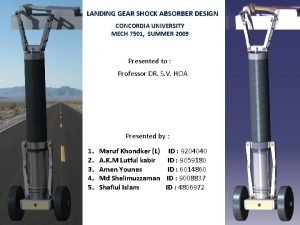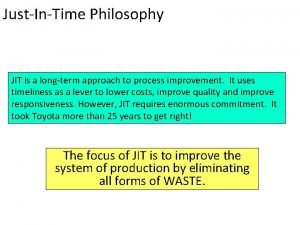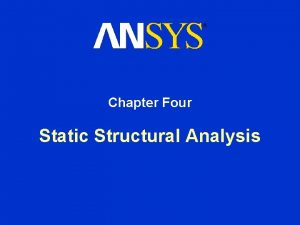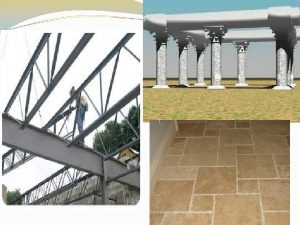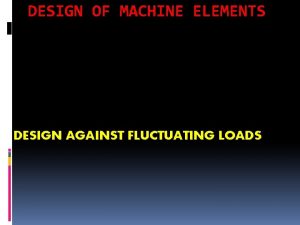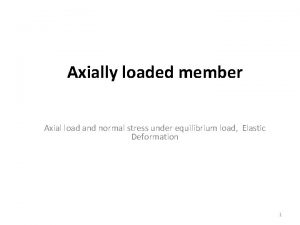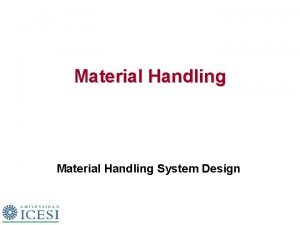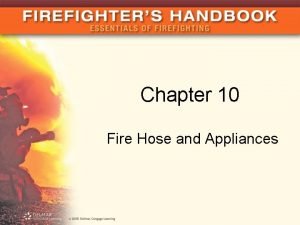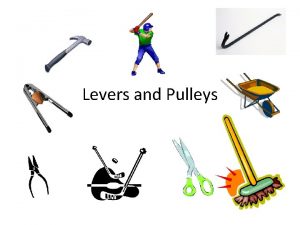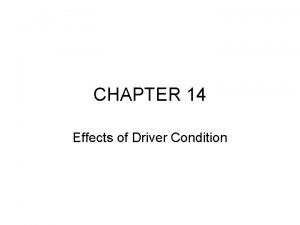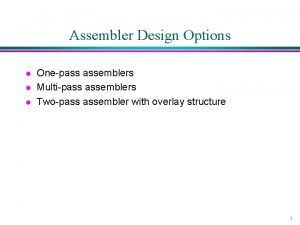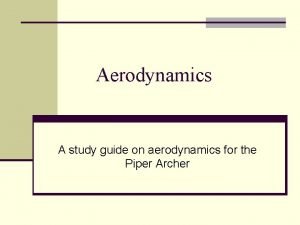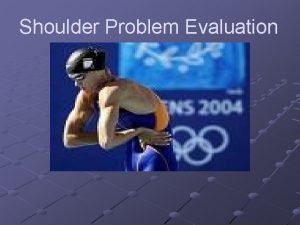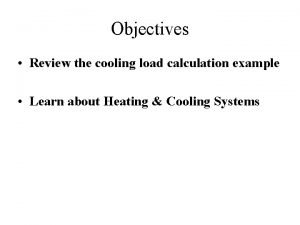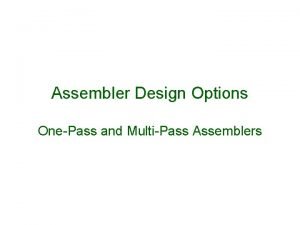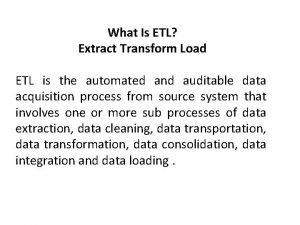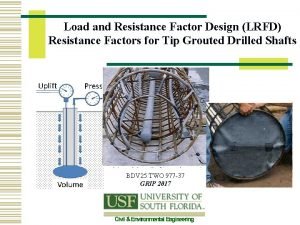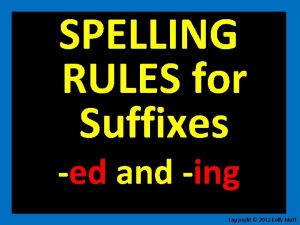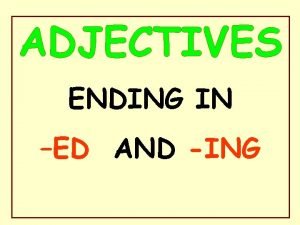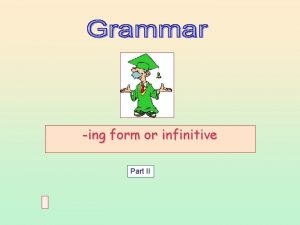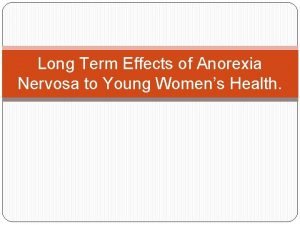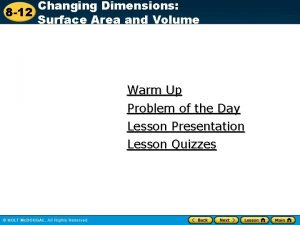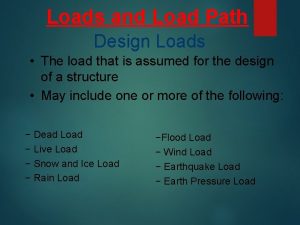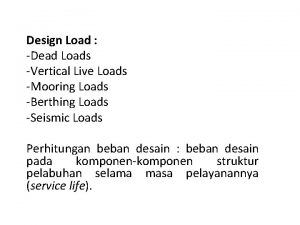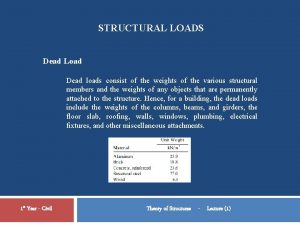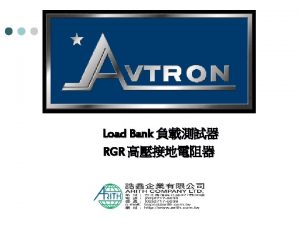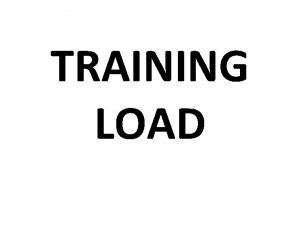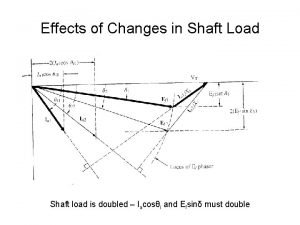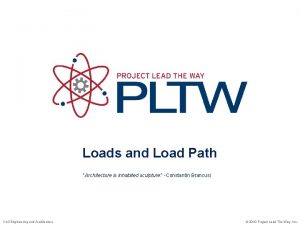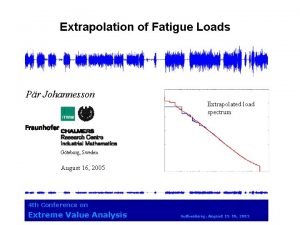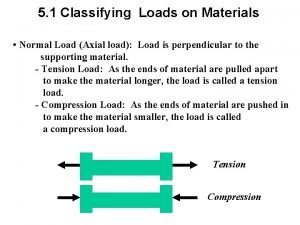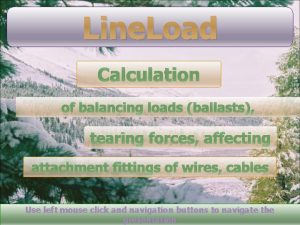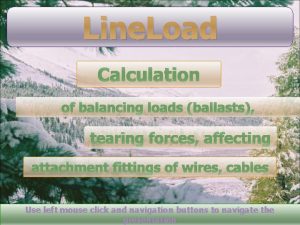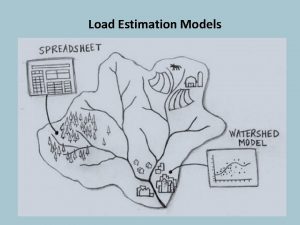Chapter 3 Loads and Load effects Dr Ing
















































































- Slides: 80

Chapter 3 – Loads and Load effects Dr. -Ing. Adil Z. Eng. Asmerom 1

Loads on Structures • Classification of loads § § Area of application: Concentrated, Distributed (UDL) Direction: Vertical (Gravity), Horizontal (Lateral) Response: Static, Dynamic Variation with time: Permanent (Dead), Variable (Live) 2

Loads on Structures • Classification of loads in Building Codes § Permanent (Dead) § Variable (Live) § Environmental Loads • • • Wind Earthquake (Seismic) Snow Rain Earth pressure 3

Wind Load EBCS -1, 1995 4

Wind load • Wind is air in motion • Structure deflects or stops the wind, converting the wind’s kinetic energy into potential energy of pressure • The wind loads that act on a structure result from movement of the air against the obstructing surfaces. • Wind effects induce forces, vibrations, and in some cases instabilities in the overall structure as well as its non-structural components. 5

Wind load • Wind velocity increases with the power of the structural height 6

Wind load 7

Wind load • These wind effects depend on: Ø the wind speed, Ø density of the air, Ø shape of the structure Ø location and geometry of the structure, and Ø vibrational characteristics of the system. • Wind Forces According to EBSC-1, 1995 wind pressure in this section is valid for rigid surface only and neglects their resonant vibration 8

Wind Load Two method of analysis is provided ü the static procedure Only used for structures whose structural properties do not make them susceptible to dynamic excitation (Cd ≤ 1. 2) ü A detailed Dynamic Procedure must be used for those structures which are likely to be susceptible to dynamic excitation (Cd > 1. 2) Ø In order to determine Dynamic coefficient Cd , Charts and figures can be used (EBCS 1 -1995 fig 3. 7 to 3. 13) 9

Wind Load 10

Wind load (the simple procedure) Wind Pressure: The external and internal wind pressures are given as: We = qref Ce (ze )cpe Wi = qref Ce (zi )cpi • Where: We and Wi are the external and internal pressures; Ce(ze ) and Ce(zi ) are the external and internal exposure coefficients; Cpe and Cpi are the external and internal pressure coefficients. • The design wind pressure that is used to establish the wind load on a structure is directly related to reference velocity pressure (qref) and is given by: 11

Wind load • Where: ρ is the density of air and Vref is the reference wind velocity to be taken as 22 m/s. • The air density is a function of altitude and depends on the temperature and pressure to be expected in the region during storms. A temperature of 200 C has been selected as appropriate for Ethiopia and the variation of mean atmospheric pressure with altitude is given in Table 2. 3. (NS) 12

• Table 2. 1 Values of air density ρ Site Altitude (m) Above sea level r (kg/m 3) 0 1. 20 500 1. 12 1000 1. 06 1500 1. 00 2000 0. 94 13

Wind load • Exposure Coefficient : takes into the account the effects of terrain, topography and elevation. Where: KT - the terrain factor Cr(z ) - the roughness coefficient Ct(z ) - the topography coefficient *** Or use table 3. 5 from EBCS-1 1995 for Ce(ze ) & Ce(zi ) (See next slide) 14

Exposure coefficient Ce Table 3. 5 from EBCS-1 1995 15

Wind load • Terrain Category: The terrain category attempts to take into account the effect of the land coverage, and is given below. The terrain type is classified into 4 groups as follows: • Category I: Lakes with at least 5 km fetch upwind and smooth flat country without obstacles. • Category II: Farmland with boundary hedges, occasional small farm structure, houses or trees • Category III: Suburban or industrial areas and permanent forests. • Category IV: Urban areas in which at least 15% of the surface is covered with buildings and their average height. 16

Wind load • Cr(z ) - the roughness coefficient ü Attempts to take into account the effect of the land coverage Ø Where zo zmin k. T terrain factor roughness length minimum height Ø For ground height above 200 m specialist advice is recommended. 17

Wind load Terrain factor (KT) can be taken from table or calculated as follows: Z 0= minimum height defined Z 0, II= minimum height of category II (0. 05) 18

Wind load • Ct(z ) - the topography coefficient ü It accounts for the increase of mean wind speed over isolated hills and escarpments Ct(z ) =1 for φ<0. 05 Ct(z ) =1+2 S φ for 0. 05≤ φ <0. 3 Ct(z ) =1+0. 6 S for φ >0. 3 Where: S the orographic location factor, φ the upwind slope H/Lu in the wind direction Le the effective length of the upwind slope, Lu the actual length of the upwind slope in the wind direction Ld the actual length of the downwind slope in the wind direction H the effective height of the feature X the horizontal distance of the site from the top of the crest z the vertical distance from the ground level of the site 19

Wind load 20

Wind load 21

Wind Load • Pressure Coefficient: The shape factor takes into account the effect of shape of structure on the pressure distribution. • The external pressure coefficients Cpe for buildings and individual parts of building depend on the size of the loaded area A. They are given for loaded area A of 1 m 2 and 10 m 2 in the relevant tables for the appropriate building configuration as cpe, 1 and cpe, 10, respectively. For areas between 1 m 2 and 10 m 2, values are obtained by linear interpolation. That is: 22

Wind Load (Ext. Pressure Coeff. ) • Cpe = Cpe, 1 +( Cpe, 10 – Cpe, 1)log 10 A • Cpe = Cpe, 10 for A≤ 1 m 2 for 1 m 2<A<10 m 2 for A≥ 10 m 2 23

Wind Load (on building face) • Values of external pressure coefficients for different cases are given in Table A. 1 to Table A. 5 of EBCS-1, 1995. 24

Wind Load (on building face) • It accounts for the variation in dynamic pressure in different zones of the structure due to • Its geometry • Area and • proximity to other structures 25

Wind Load (on building face) 26

Wind Load (on building face) • Reference height and wind pressure profile 27

Wind Load (on building face) • Reference height and wind pressure profile 28

Wind Load (on building face) EXTERNAL PRESSURE COEFFICIENTS FOR VERTICAL WALL. 29

Wind Load (on flat roofs) • Flat roofs are defined as having a slope (α) of – 5°< α < 5° • The roof should be divided into zones as shown in Figure below. 30

Wind Load (on flat roofs) 31

Wind Load (on flat roofs) • External pressure coefficients for flat roof 32

Wind Load (on Monopitch roofs) • The roof, including protruding parts, should be divided into zones as shown in Figure below and NS • The reference height Ze should be taken equal to h. 33

Wind Load (on Monopitch roofs) 34

Wind Load (on Monopitch roofs) • External pressure coefficients for Monopitch roof =0º and ϴ =180º ϴ 35

Wind Load (on Monopitch roofs) • External pressure coefficients for Monopitch roof ϴ =90º 36

Wind Load (on Duo pitch roofs) • The roof, including protruding parts, should be divided into zones as shown in Figure below and NS • The reference height Ze should be taken equal to h. 37

Wind Load (on Duo pitch roofs) 38

Wind Load (on Duo pitch roofs) • External pressure coefficients for Duopitch roof ϴ =0º 39

Wind Load (on Duo pitch roofs) • External pressure coefficients for Monopitch roof ϴ =90º 40

Wind Load (on Hipped roofs) • The roof, including protruding parts, should be divided into zones as shown in Figure below and NS • The reference height Ze should be taken equal to h. 41

Wind Load (on Hipped pitch roofs) 42

Wind Load (on Hipped pitch roofs) • External pressure coefficients for Monopitch roof =0º and ϴ =0º ϴ 43

Wind Load Internal pressure Coefficient Cpi • Internal and external pressures shall be considered to act at the same time. The worst combination of external and internal pressures shall be considered for every combination of possible openings and other leakage paths. • The internal pressure coefficient Cpi for building w/o internal partition is a function of opening ratio m defined as 44

• For closed buildings with internal partitions and opening windows the extreme values : Cpi = 0. 8 and Cpi = -0. 5 45

Wind load Net pressure: the difference of the pressures (external and internal) on each surface due account of their signs. 46

Local effects of wind pressure • Wind around a corner Images from FEMA Multi Hazard Seminar 47

Local effects of wind pressure Images from FEMA Multi Hazard Seminar 48

Local effects of wind pressure • Uplift on roof Images from FEMA Multi Hazard Seminar 49

Local effects of wind pressure Images from FEMA Multi Hazard Seminar 50

Earthquake Load EBCS -8, 1995 51

Earthquake Load n An earthquake is the vibration of Earth produced by the rapid release of accumulated energy in elastically strained rocks. It is the earth’s natural means of releasing stress. Energy released radiates in all directions from its source, the focus; n Energy propagates in the form of seismic waves; n 52

Types of Earthquakes • Tectonic Earthquakes: occur when rocks in the earth's crust break due to geological forces created by movement of tectonic plates. • Volcanic Earthquakes: occur in conjunction with volcanic activity. • Collapse Earthquakes: are small earthquakes in underground mines, • Explosion Earthquakes: result from the explosion of nuclear and chemical devices. * About 90% of all earthquakes result from tectonic events, primarily movements on the faults

Basic principles of conceptual design • The guiding principle in conceptual design against seismic hazard are: § structural simplicity § uniformity and symmetry § bidirectional resistance and stiffness § torsional resistance and stiffness § diaphragmatic action at storey level § adequate foundation 54

Consequence of structural regularity on seismic design EBCS 8, 1995 REGULARITY SIMPLIFICATION PLAN ELEVATION MODEL ANALYSIS BEHAVIOR FACTOR Yes Planar Static* Basic Yes No Planar Static* Increased No Yes Spatial Static* Basic No No Spatial Dynamic Increased * Fundamental period < 2 seconds 55

Regularity in Plan • symmetric in plan w. r. t. 2 orthogonal directions • compact plan configuration (no H, I, X shapes) Reentrants in one direction <25% • In-plane stiffness of floors sufficiently large compared to stiffness of vertical elements • Under the equivalent static seismic force, max. displacement in the direction of seismic force does not exceed avg. displacement by 20% 56

Regularity in elevation • All lateral load resisting systems run without interruption from foundation to top • Both lateral stiffness & mass of story's remain constant or reduce gradually without abrupt changes • ratio of actual storey resistance to required resistance should not vary disproportionately between adjacent storeys. 57

Regularity in elevation (contd. ) when setbacks are present: 58

Earthquake Analysis of Linear Systems • Equivalent static analysis (ESA) • Dynamic analysis § Response history analysis (RHA) or (THA) § Response spectrum analysis (RSA) 59

EBCS 8 Elastic Design Spectra 60

Equivalent Static Analysis, EBCS 8, 1995 • Base shear force, Fb = Sd(T 1) W • Fundamental period, T 1 = C 1 H 3/4 ; T 1 = 2 • Sd (T 1) = abg • Distribution of lateral force Rayleigh coefficient Not explicitly shown • Accidental torsion, eli = ± 0. 05 Li • Torsional effects in individual elements, d=1+0. 6 x/Le 61

Design spectrum coefficients a= ao. I bedrock acceleration ao=0. 1, 0. 07, 0. 05, 0. 03 acceleration ratio I = 1. 4, 1. 2, 1. 0, 0. 8 importance factor response factor S = 1. 0, 1. 2, 1. 5 g= gok. D k. R k. W 0. 70 site coefficient behavior factor 62

Seismic Hazard map of Ethiopia bedrock acceleration coefficient ao ao = 0. 05 g 0. 1 g 63

Importance factors for buildings Importance category Buildings Importance factor I Bldgs whose during EQ is vital importance, e. g. hospitals, fire stations, . . . 1. 4 II Bldgs whose collapse results in serious consequence, e. g. schools, assembly halls, 1. 2 III ordinary buildings not belonging to other categories 1. 0 IV Bldgs of minor importance for public safety, e. g. agricaltural bldgs. , etc. 0. 8 64

Comparing acceleration coefficients b in ESA and A/g in design spectrum are not identical 65

Subsoil classification Subsoil class Description Site coeff. S A Rock vs 800 m/s in the top 5 m and stiff clay deposits vs 400 m/s at 10 m depth 1. 0 B medium dense sand, gravel or medium stiff clays vs 200 m/s at 10 m depth 1. 2 C Loose cohesionless soil deposits with or without some soft cohesive layers vs < 200 m/s in the uppermost 20 m where vs is shear wave velocity 1. 5 66

Torsional effects • Spatial (3 D) model, accidental torsional effects Mli = eli Fi where Mli torsional moment at storey i eli accidental eccentricity of storey mass i (eli = ± 0. 05 Li) Fi horizontal force acting at storey i • Planar (2 D) models: amplify the action effects in individual load resisting elements with a factor d (d=1+0. 6 x/Le) • If torsional irregularity exists, increase eli by 67

Scaling of results • when base shear determined from procedures of RSA < ESA: § base shear shall be increased to the following %age of the values determined from ESA • 100% for irregular buildings • 90% for regular buildings deflections, member forces and moments increased proportionally 68

Combination of components of seismic action • Horizontal components shall be considered to act nonconcurrently • Vertical components amounting to 70% of the horizontal components shall be taken into account for: § horizontal (or nearly) members spanning 20 m § horizontal (or nearly) cantilever components § horizontal (or nearly) prestressed components § beam supporting columns analysis is made on a partial model consisting of the element under consideration and adjacent elements 69

Determination of displacements • Displacements induced by the design seismic action: d s = d e / gd where ds = displacement due to design seismic action de = displacement from linear analysis based on design spectrum (shall also include torsional effects) gd = displacement behavior factor 70

Safety Verifications 1. Ultimate limit states safety against collapse (ULS) is ensured if resistance, ductility, equilibrium, foundation stability and seismic joint conditions are met a. Resistance condition § § Design action effects design resistance; Ed Rd Second order effects: Interstorey drift sensitivity coeff. , if 0. 10 no need to consider 0. 1 < 0. 2 consider 2 nd order effects by amplifying results by a factor 1/(1 - ) shall not exceed 0. 25 71

Safety Verifications (contd. ) b. Ductility condition § § check that the structural elements and the structure as a whole posses adequate ductility specific material related requirements shall be satisfied c. Equilibrium condition § § bldg. should be stable against overturning and sliding additional SLS verification for bldgs with sensitive equipments d. Resistance of horizontal diaphragms § § Horizontal diaphragms & bracings shall have sufficient overstrength in transmitting lateral loads The above requirements are satisfied if the diaphragms can resist 1. 3 times forces obtained from analysis 72

Safety Verifications (contd. ) e. Resistance of foundation § § § Verification of foundations according to EBCS 7. Action effects based on capacity design consideration, but shall not exceed that of linear behavior with g =1. If the action effects are determined using g ≥ 0. 7, no capacity design consideration is needed f. Seismic joint condition § To check that there is no collision with adjacent structures • • • Distance between potential points of impact < max. ds When floor elevations of adjacent bldgs are the same the max. separation distance referred above can be reduced by a factor of 0. 7 If shear (bumper) wall provided on the perimeter of the bldgs no separation distance needed, a 40 mm separation can be used for the rest of the bldg. 73

Safety Verifications 2. Serviceability limit states limitation of damage requirement (SLS) is satisfied if, under the design seismic action, the interstorey drifts dr are limited to: a. For bldgs having non-structural elements of brittle materials attached to the structure dr ≤ 0. 01 h b. For bldgs having non-structural elements fixed in a way not to interfere with structural deformations dr ≤ 0. 015 h where h is the storey height c. Additional SLS verification may be req’d for important bldgs containing sensitive equipments 74

Design provisions for concrete buildings • Design Concepts: § EQ resistant concrete bldgs shall provide adequate energy dissipation capacity § Overall ductile behavior is ensured if the ductility demand is spread over a large number of elements. Ductile mode of failure (flexure) should precede brittle failure modes (shear) § With regard to required dissipation capacity, three ductility classes are set to provide appropriate amount of ductility § Different behavior factors g are used for each ductility class § In seismic zones 1 & 2 design load combinations according to EBCS 2 provisions with an appropriate g. 75

Ductility Classes • Depending on the required hysteretic dissipation capacity § DC”L” (low ductility) • structures designed and dimensioned according to EBCS 2 • concrete class C 20 § DC”M” (medium ductility) • specific provisions for design and detailing to ensure inelastic behavior of the structure without brittle failure • concrete class C 25 § DC”H” (high ductility) • special provisions for design and detailing to ensure stable mechanisms with large dissipation of hysteretic energy • concrete class C 25 76

Behavior factors g • g = gok. D k. R k. W 0. 70 § go = basic value of structural response, depends on structure type Structural type go Frame system 0. 20 Dual system Wall system Frame equivalent 0. 20 Wall eqv with coupled walls 0. 20 Wall eqv with uncoupled walls 0. 20 with uncoupled walls 0. 25 Core system 0. 30 Inverted pendulum system 0. 50 77

Behavior factors g (contd. ) • k. D = factor reflecting ductility class § k. D = 1. 0 for DC”H”, § k. D = 1. 5 for DC”M”, § k. D = 2. 0 for DC”L”. • k. R = factor reflecting structural regularity in elevation § k. R = 1. 00 for regular structures § k. R = 1. 25 for irregular structures • k. W = factor reflecting the prevailing failure mode in structural systems with walls § 1. 00 for frame and frame equivalent systems § (2. 5 – 0. 5 ao) 1. 0 for wall, wall equivalent systems and core systems 78

Design criteria for concrete bldgs • local resistance criterion § all critical regions shall have adequate resistance § second order effects shall be taken into account • capacity design criterion § brittle or undesirable failure mechanisms shall be prevented, (e. g. shear failure of elements, BCJ failure, or yielding of foundation) § plastic hinges shall be distributed throughout the structure, only in beams and not in columns except at the base of the bldg. (refer to the next slide) 79

Choice of ductile mode failure 80
 Bearing
Bearing Load paths
Load paths Bed load and suspended load transport
Bed load and suspended load transport The point of intersection of dc and ac load line
The point of intersection of dc and ac load line Latent loads
Latent loads Forms and shores must not be removed until
Forms and shores must not be removed until Employers must not place construction loads
Employers must not place construction loads Fire hose appliances
Fire hose appliances Mechanical load on human body
Mechanical load on human body The pipe assembly supports the vertical loads shown
The pipe assembly supports the vertical loads shown The structural members supporting loads at various points.
The structural members supporting loads at various points. Archimedes principle
Archimedes principle Storage bins and silos must be equipped with bottoms
Storage bins and silos must be equipped with bottoms Landing gear loads
Landing gear loads Just in time philosophy
Just in time philosophy Static structure analysis
Static structure analysis Members used to carry wall loads over wall openings
Members used to carry wall loads over wall openings Soderberg equation
Soderberg equation A building bent deflects in the same way as
A building bent deflects in the same way as St venant principle
St venant principle Racking stress of container
Racking stress of container Unit load in material handling
Unit load in material handling Shoulder loop hose carry
Shoulder loop hose carry Chapter 12 reconstruction
Chapter 12 reconstruction What was reconstruction? *
What was reconstruction? * Fle 123 levers
Fle 123 levers Effects of driver condition
Effects of driver condition Chapter 14 effects of driver condition
Chapter 14 effects of driver condition Causes and effects of the french and indian war
Causes and effects of the french and indian war Load and store instructions example
Load and store instructions example What is assembly language in computer
What is assembly language in computer Load bearing vest pros and cons
Load bearing vest pros and cons Load and go assembler
Load and go assembler Traffic throttling and load shedding
Traffic throttling and load shedding Probability theory in hashing and load balancing
Probability theory in hashing and load balancing Load and go assembler
Load and go assembler Maximum endurance speed
Maximum endurance speed How to calculate maneuvering speed
How to calculate maneuvering speed Airplane left turning tendencies
Airplane left turning tendencies Yergason test
Yergason test One pass assembler and multi pass assembler
One pass assembler and multi pass assembler Cooling load calculation example
Cooling load calculation example Lesson plan for from a railway carriage
Lesson plan for from a railway carriage Explain multi pass assembler in detail
Explain multi pass assembler in detail Extract transform and load automation
Extract transform and load automation Difference between performance and load testing
Difference between performance and load testing Load and resistance factor design
Load and resistance factor design Ed
Ed The verb estar (p. 107)
The verb estar (p. 107) Adjectives ending in ed and ing
Adjectives ending in ed and ing Ing and to infinitive
Ing and to infinitive Drink gerund or infinitive
Drink gerund or infinitive Jerunds
Jerunds Gerund expressions
Gerund expressions Primary and secondary effects of a tectonic hazard
Primary and secondary effects of a tectonic hazard Pinotubo
Pinotubo Car thrust angle
Car thrust angle Causes and effects of the russian revolution
Causes and effects of the russian revolution Causes and effects of french revolution
Causes and effects of french revolution Effects of the cotton gin
Effects of the cotton gin Short term causes of the french revolution
Short term causes of the french revolution French revolution
French revolution Positive and negative effects of television
Positive and negative effects of television Cold war causes and effects
Cold war causes and effects Strengths of the continental army
Strengths of the continental army Effects of light on smart and modern materials
Effects of light on smart and modern materials French revolution causes and effects
French revolution causes and effects Business expansion: conglomerates and franchises effects
Business expansion: conglomerates and franchises effects Pollution causes effects and solutions
Pollution causes effects and solutions What is passive movement
What is passive movement French revolution causes and effects
French revolution causes and effects Marine noise pollution
Marine noise pollution American revolution causes and effects
American revolution causes and effects Short term effects of anorexia
Short term effects of anorexia French revolution causes
French revolution causes Forest fires causes and effects
Forest fires causes and effects Effects of internet use and study habits
Effects of internet use and study habits What is covetous
What is covetous What is covetous
What is covetous Effects of changing dimensions on surface area and volume
Effects of changing dimensions on surface area and volume Effect of russian revolution
Effect of russian revolution


